National Santa Dash
On Friday, all children took part in the National Santa Dash. This event was all about having some fun whilst being active.
We’ve decided to extend this event: we’ll be holding an Easter and Summer Dash, too! Our goal is to allow pupils to set some targets and improve on their personal bests through the year.
Here are some photos – enjoy!





Philosophy Friday – 06.12.24
Philosophy is thinking deeply.
Every Friday, we start our day with some time to wonder and ponder.
We’ve a different question each week – there’s no obvious right/wrong answer and no underlying moral message. All children are given the opportunity to contribute their ideas and give reasons for their thoughts.
This week’s question related to our living and learning statement:


This question sparked some interesting discussion and debate.
People might be sad if they don’t do the right thing to each other.
– Esme
Being kind to yourself is everyone’s responsibility
– Vincent
This links to respect and tolerance. You have to respect others and yourself to be kind.
– Woody
Our oracy focus this half term is:

Help at home by discussing this week’s Philosophy Friday question with your child. Does this question link to any of our Christian values?
Science – Materials
In science, we’re learning about materials. We’ve been exploring a variety of everyday materials, including their properties and uses.
This week, we’ve learnt that some solid objects can change shape.
- stretch – to make something longer without ripping, breaking or tearing
- bend – to force something to curve
- squash – to crush or squeeze something
- twist – to bend or curl something out of shape
We collected a variety of everyday objects ready to test. We worked like scientists by planning our investigation and making predictions.

We tested each object by stretching, bending, squashing and twisting.



We recorded our results and checked them against our predictions. The children were precise and meticulous, both in making their predictions and carrying out the test.
Help at home by asking your child how they’ve worked like a scientist during our materials unit? Challenge them to complete the vocabulary matching task below.

Philosophy Friday – 29.11.24
Philosophy is thinking deeply.
Every Friday, we start our day with some time to wonder and ponder.
We’ve a different question each week – there’s no obvious right/wrong answer and no underlying moral message. All children are given the opportunity to contribute their ideas and give reasons for their thoughts.
This week’s question related to our current topic:
This half-term, we’re artists. We’ll develop our art knowledge and skills.
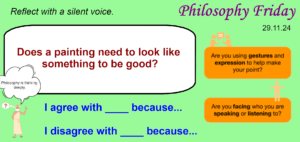
This question sparked some interesting discussion and debate.
It doesn’t even have to be good. You can do anything you want as long as you had a good time doing it.
– Freddy
It’s always going to look nice to someone. I believe you should do whatever you want.
– Izabella
If every painting looked like something, it could be a bit boring. It could just be colours and shapes.
– Olly
It’s the colours that make a painting beautiful.
– Ellis
Our oracy focus this half term is:

Help at home by discussing this week’s Philosophy Friday question with your child. Can you find any examples of art that don’t immediately jump out as resembling something?
Living and Learning – I can talk about my feelings
This week’s Living and Learning statement is:
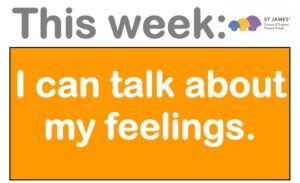
We discussed a range of emotions and the importance of recognising and talking about them.
Emotions are feelings – they can change all the time. We all experience a whole range of emotions, from anger to happiness to fear. This is ok and normal.
Emotions and feelings are our mental health.
We talked about how we can read people’s faces and body language to help us understand how they might be feeling. The children had a go at showing what these emotions might look like.

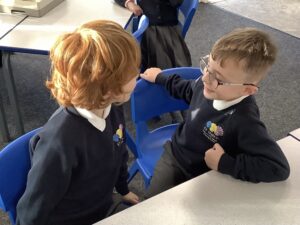
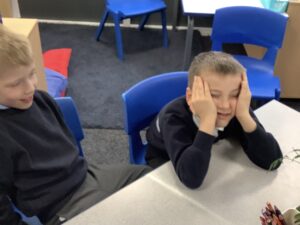
Everyone has the right to ask for help. If you need help with your emotions, or you notice someone else might need help with their emotions, speak to a trusted adult.
Help at home by discussing this learning with your child. Encourage your child to talk about their feelings – do they know who to speak to at school if they need help with their emotions?
Why not try completing this emotions chart with your child to highlight how emotions can change over the course of a day or event?
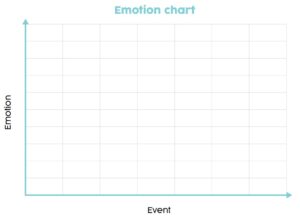
Reading – Inference
In reading, we’ve been reading The Three Little Wolves and the Big Bad Pig by Eugene Trivizas and Helen Oxenbury.
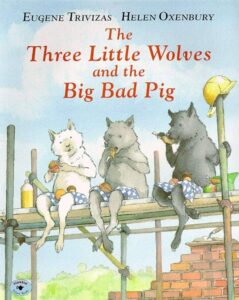
It’s a comically inverted version of the classic fable and the children have thoroughly enjoyed reading it. We spent some time discussing the pig’s character:
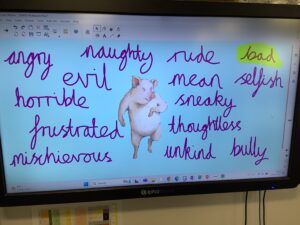
We’ve been using the text as a vehicle to practise our inference skills. Inference is the skill of using clues to make a sensible guess about something we don’t know.
One of our favourite activities for practising inference is ‘hot seating’ in which characters, played by members of the class (or the teacher!), are interviewed by the rest of the group. It encourages children to embody a character, thinking deeply about themes and ideas, and exploring their behaviour. We had great fun pretending to be the big bad pig!
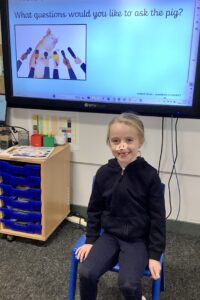
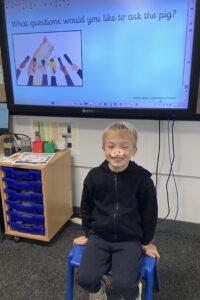
Help at home by trying a hot seat activity with your child’s current book. Can they embody a character and dramatise their behaviour?
PE – Gymnastics
This half term, our focus in PE is gymnastics.
We’ve been exploring movement – the different ways in which we can control our bodies and travel from one point to another. We’ve considered the height of our position and how it can change.
The children created and performed sequences, giving feedback to each other. I was astounded by the flexibility, balance and creativity on display!
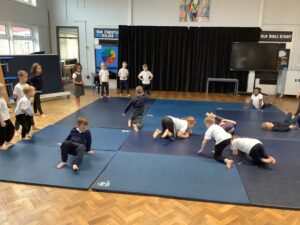
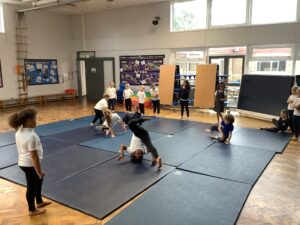
Help at home by discussing movement with your child. How can we move in different ways? Perhaps you could explore the movements of some animals – how do they move their bodies differently to ours?
Me and My Community Week
Wetherby Brass Band
On Tuesday, we were lucky to have a visit from Steven from Wetherby Brass Band. He spoke to the whole school about the benefits of playing in a band and being part of a community within the Wetherby community.
Steven, brought in some instruments and some of us were lucky enough to play some of them – some made hilarious noises.







The band play during many events in the Wetherby community, including the Remembrance Parade. They also play every Sunday at 2.30-4.30pm from the end of April to the end of September.
Me and My Community – Caring for Our Community
What is a community?
Communities are made up of people who are connected in some way. They might share common interests and values.
The children came up with a list of people who make up our community:
- families
- friends
- police
- teachers
- shop owners
- doctors
- neighbours
- church
We are connected to these people in lots of different ways and they all play a part in making our community a happy and healthy place to achieve and believe.
We thought about our classroom community and how we’re connected to one another. To show our community and its importance, children passed the string to the next person, whilst offering some words of appreciation, encouragement or support.


The web shows our classroom community. If we all show care and support, it will be strong.
We then dropped the string…
When people stop caring and supporting, the community will start to have problems.
What if we cared MORE not less?
Help at home by discussing this question with your child. You could use these stem sentences to help:
- To support my family community at home, I could…
- To care for my school community, I could…
- To help my local community, I could…
Me and My Community – Our School Vision
As part of our themed week, Me and My Community, we spent some time discussing our school vision.
Our school vision is to be…
…a happy and healthy place to achieve and believe.
We picked out 4 key words from our vision:
-
happy
-
healthy
-
achieve
-
believe
We discussed each word, thinking about what ‘happy and healthy’ looks and feels like, and all the ways in which we ‘achieve and believe’
“We can be happy by playing together.”
“We stay healthy by washing our hands.”
“We can achieve by working together.”
“We can believe by cheering each other on.”
Help at home by discussing our school vision with your child. How is our school vision reflected in life outside of school?